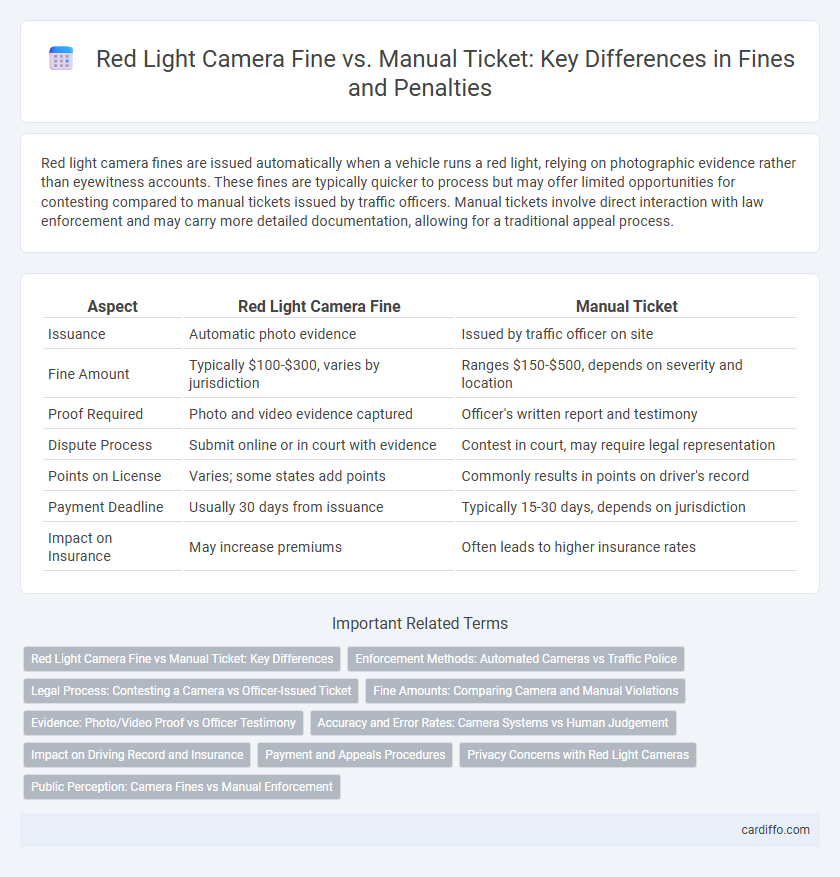Red light camera fines are issued automatically when a vehicle runs a red light, relying on photographic evidence rather than eyewitness accounts. These fines are typically quicker to process but may offer limited opportunities for contesting compared to manual tickets issued by traffic officers. Manual tickets involve direct interaction with law enforcement and may carry more detailed documentation, allowing for a traditional appeal process.
Table of Comparison
| Aspect | Red Light Camera Fine | Manual Ticket |
|---|---|---|
| Issuance | Automatic photo evidence | Issued by traffic officer on site |
| Fine Amount | Typically $100-$300, varies by jurisdiction | Ranges $150-$500, depends on severity and location |
| Proof Required | Photo and video evidence captured | Officer's written report and testimony |
| Dispute Process | Submit online or in court with evidence | Contest in court, may require legal representation |
| Points on License | Varies; some states add points | Commonly results in points on driver's record |
| Payment Deadline | Usually 30 days from issuance | Typically 15-30 days, depends on jurisdiction |
| Impact on Insurance | May increase premiums | Often leads to higher insurance rates |
Red Light Camera Fine vs Manual Ticket: Key Differences
Red light camera fines are issued automatically when a vehicle crosses an intersection after the signal turns red, using surveillance technology to capture violations without officer presence. Manual tickets require a traffic officer to witness the infraction in real-time and issue a citation on the spot, often involving more discretion in enforcement. Red light camera fines tend to be processed faster and rely on photographic evidence, while manual tickets may allow for immediate contestation or discussion with the issuing officer.
Enforcement Methods: Automated Cameras vs Traffic Police
Red light camera enforcement relies on automated technology to capture violations with timestamped evidence, reducing human error and ensuring consistent monitoring at intersections. Traffic police manually issue tickets by observing offenses in real-time, allowing for immediate interaction but increasing potential for subjective judgment and limited coverage. Automated cameras enhance efficiency and data accuracy, while manual enforcement provides a personalized approach to traffic law compliance.
Legal Process: Contesting a Camera vs Officer-Issued Ticket
Contesting a red light camera fine typically involves submitting a formal written challenge or attending a hearing where evidence such as camera footage or photographs can be reviewed, while officer-issued tickets often require appearing in court to cross-examine the issuing officer. Legal procedures for camera fines may allow for reduced penalties if procedural errors are identified, whereas manual tickets rely heavily on the officer's testimony and presence to contest the citation. Understanding jurisdiction-specific rules and deadlines for contesting either type of ticket is critical for an effective defense.
Fine Amounts: Comparing Camera and Manual Violations
Red light camera fines often range from $50 to $200, depending on the jurisdiction, while manual ticket fines for the same violation can exceed $300 due to higher court or officer-imposed penalties. Camera violations typically carry standard fine amounts set by local traffic regulations, whereas manual tickets allow for variable fines based on the officer's discretion and severity of the offense. In many areas, camera fines may not add points to the driver's license, unlike manual tickets which often result in points and increased insurance rates.
Evidence: Photo/Video Proof vs Officer Testimony
Red light camera fines rely heavily on photo and video evidence that clearly capture the vehicle violating traffic signals, providing indisputable proof of the offense. Manual tickets, however, depend primarily on the officer's testimony and observation at the scene, which may be subject to human error or bias. Courts often consider automated camera evidence more objective and reliable compared to eyewitness accounts from officers.
Accuracy and Error Rates: Camera Systems vs Human Judgement
Red light camera systems demonstrate higher accuracy and lower error rates compared to manual ticketing by human officers, as automated imaging reduces subjective judgment and human error. Studies indicate camera enforcement captures violations consistently at rates exceeding 90%, whereas manual ticketing accuracy can vary significantly due to factors like timing and perspective. Enhanced precision from red light cameras supports fairer enforcement and fewer wrongful citations, improving overall traffic law compliance.
Impact on Driving Record and Insurance
Red light camera fines typically do not add points to a driver's record, reducing the potential impact on insurance premiums compared to manual tickets issued by police officers. Manual tickets often result in points added to the driving record, which insurance companies commonly use to increase rates due to perceived higher risk. The absence of points from camera violations can help drivers maintain lower insurance costs and a cleaner driving history.
Payment and Appeals Procedures
Red light camera fines often have automated payment systems, allowing offenders to pay online or by mail, streamlining the process compared to manual tickets that usually require in-person payments. Appeals for red light camera violations typically involve submitting evidence or contesting the citation through a municipal traffic court or an administrative review board, whereas manual ticket appeals often necessitate a court appearance. Both methods provide specific deadlines for payment and appeals, making adherence crucial to avoid additional penalties or license suspensions.
Privacy Concerns with Red Light Cameras
Red light cameras raise significant privacy concerns due to constant surveillance and the collection of personal vehicle data without explicit consent. Unlike manual tickets issued by police officers, these automated systems capture images and video that may be stored and potentially misused. The lack of transparency in data handling and long-term storage policies intensifies public apprehension regarding individual privacy rights.
Public Perception: Camera Fines vs Manual Enforcement
Public perception often views red light camera fines as more impartial and less influenced by officer bias compared to manual ticketing. Studies reveal a higher acceptance of automated enforcement since it relies on objective photographic evidence rather than subjective judgment. Despite concerns about privacy and accuracy, many drivers perceive camera fines as a fairer deterrent for traffic violations.
Red light camera fine vs manual ticket Infographic

 cardiffo.com
cardiffo.com